I was shocked when we pulled up to the Creation Museum in Petersburg, Kentucky. The place was mobbed. We had to search for a parking place. Somewhere I had read that they had upped the entertainment value by installing a zipline; apparently attendance was not reaching goals. This didn’t look like an organization with attendance problems, though. I had snickered and stopped for a picture of the stegosaurus-adorned gates up on Bullittsburg Church Road (itself something of a snarkworthy address). I had planned the adventure as a bit of comic relief during an otherwise high-culture itinerary.
But this was all just weird.
We walked past a woman brightening the metallic-bronze painted surface of a dinosaur statue; my Dear One asked if the color had faded from the sun and the woman working said no, from all the effects of weather. The hallway through which we entered had posters and displays suggesting that the tradition of dragons in history is evidence that dinosaurs existed within human memory. We bought our tickets (senior discounted but still $60 for the two) and moved with some trepidation toward the entry point of the main display.
From there it was one disturbing “fact” after another.
The “Museum” structures history as the “7 C’s in God’s Eternal Plan: Creation, Corruption, Catastrophe, Confusion, Christ, Cross, Consummation.” This “history” purports to demonstrate that the world was Created by the god of fundamentalist Christians and ancient Hebrews in six twenty-four-hour days about six thousand years ago. Corruption came about with Adam’s disobedience and Catastrophe ensued with the Flood. This sequence is supported by a reading of the paleontological record that “explains” how geology and fossils prove the “fact” of the great deluge which only Noah, his family, and his selected pairs of animals survived.
And I had never realized that all animals were originally vegetarian. Meat-eating is, apparently, another ill-effect of the Fall. Lions, tigers and bears, and T-Rexes and vultures, oh my, wouldn’t have dreamed of such a protein-dense diet before Adam sinned.
After lengthy and complicated displays about the “scientific” record and the Garden of Eden, there was a major installation on the Flood and Noah’s Ark. We learned a lot about how the Ark was made, how the animals were cared for—and yes, we learned that there were dinosaurs on the Ark. Space limitations were explained away by pointing out that Noah would certainly have chosen young creatures rather than full-grown ones. The subsequent extinction of dinosaurs resulted from over-hunting.
There was no lingering over Confusion. The sons of Noah—Shem, Ham and Japheth—headed out to Asia, Africa and Europe respectively but apparently failed to procreate in numbers that pleased God so the next round of punishment involved the shattering of the Tower of Babel into the babble of languages. Somewhere along, my concern about where this limited population was finding mates was addressed. All people, as descendants of Adam and Eve, are related and it was perfectly okay for the children and grandchildren of the Founding Couple to make babies with each other because their genetic material was nearly perfect, only slightly sullied from the matter of Original Sin. Nowadays, though, we are far removed from Eden and so our DNA is so damaged that breeding with “close relatives” will result in terrible birth defects. Today, sensibly, breeding with “close” relatives is discouraged.
The dénouement was a stroll through dark and dismal precincts that illustrated the depth of human depravity. This is where Christ and Cross come in but we opted to skip to film that covered this post-diluvian narrative of salvation. Consummation—the final “C” could as easily be attached to Second Coming—will bring the cycle back to Creation. God gets a do-over, remaking His world, “cast[ing] out death and the disobedient.”
I’m still struggling with the idea that God will have to cast out death and the disobedient at the Consummation. Wouldn’t He have figured out how to avoid all that hassle and pain the next time round? I mean, if he is starting over from the beginning, why not just do it all perfectly? Oh, wait a second, God did do it perfectly the first time and it was Evil in collusion with God’s effigy that sent things down the wrong path. So God also made Evil? Yes? No? Oh dear. Religion is so incompatible with logic.
But then, it’s not about logic and it certainly isn’t about science. It’s all about faith and human claims to knowing what God really has in mind.
We returned to our car and headed back to our Hampton Inn in Covington along the Ohio River. Route 8 (aka River Road) winds through woods past the occasional farmhouse or village center. The foliage was scarlet and yellow, and a field of orange pumpkins caught my eye and showed me the trees behind and through a break a glimpse of the Ohio. I drove slowly, luxuriating in the bends and curves, pulling over every so often to let pass locals in more of a hurry.
I can’t however erase from my mind images of young people intently studying those displays, attentively reading the texts, looking at length at the dioramas. If they had entered the museum with doubts, with a certain readiness to accept the premises of evolution, to see the world as the product of the processes of Nature rather than the deliberate and “intelligent” design of a divinity, then they seemed to be leaving cocooned in the impenetrable fog of religious dogma.
What disturbs me most is that these are the young people who will shape the future, determine my medical care as I lie in the Old Folks Home, make decisions about war, about the health of the environment, about the possibilities of art, of scientific discovery, of the very existence of imagination as an essential route to Truth.
So I thought the Creation Museum would simply be an Amusement Park. But it wasn’t fun and I’m not laughing.

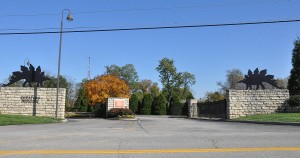
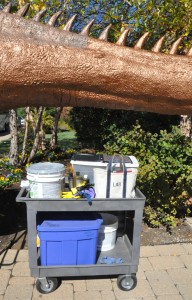
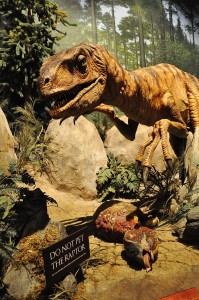
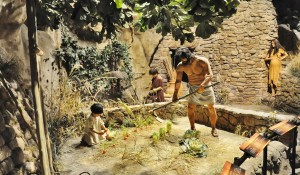
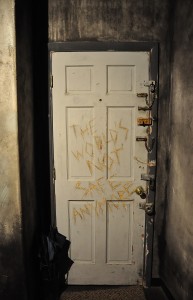
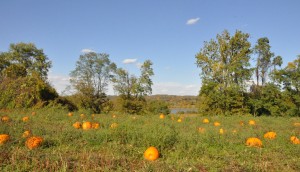

You must publish this. But you must tell us more. First off I love the pictures. You must tell what’s to like about the museum. The pictures are great. Is that to like? If you didn’t come to this museum with your science knowledge, would you like the way it is arranged–is it clever–is it vast–where are the pictures from–who are the artists–what is the history of the museum? Who founded it? Who donated the money etc. How science is taken and twisted for the purpose of the theory of creation. How does this affect knowledge and the dissemination of science in the South.
Would this be a good museum if we explain this is what we believe in our profound ignorance? Was there a sign in book? Did you get to read what people said in the sign in book? Did you get to talk to people there and get their opinions or were you too aghast to do this? If you did talk to someone or many someones then what did they say? Did you eat in their cafeteria? Did you talk to the cafeteria workers? How many jobs does this museum provide? Who is the curator? You know the spiel. But those are things I’d like to know.
The Hindus have a far more sensible deal. In our creation story Brahma created the world and then he went to sleep for eons–calculated to be 4.5 billion years. He really doesn’t interfere in human endeavors because his job is just to create. The job of Vishnu is to protect and the job of Shiva is to destroy. Brahma simply builds and after building or rebuilding the universe, after many cycles of birth and death, he slumbers. He needs his beauty rest. Quite cute actually.
Anyway you must also tell us how this museum does not hew to the view in the Bible. It takes Bible stories and twists them to disseminate lies about the Bible. There were no dinosaurs on Noah’s boat. This is a museum that says apocryphal stories about the story of creation–taking liberties there makes it rather heretical or blasphemous or whatever you want to call it.
It’s fascinating that meat eating was a falling from grace. In Hinduism, in Buddhism, also in Jainism, a respect for animals as ones own brothers and sisters is the norm. Cruelty to animals is considered sadistic and the practice of ahimsa, which is non violence, is considered a high form of human thought and evolution.
That humans fell from grace when they destroyed and ate animals is not a far out thought–a veggie burger dame like me thinks that’s fine. It is true of many religions they propound this. When you look at conservation and the environmental movement today, the extinction of species and the depletion of sea life demands we have more respect for animals. Besides sustainable development wants us to call off animal farming, industrial farming, GM farming etc.
I know, I know–the creation museum was not saying any of that–just that people were vegetarians before they fell from the grace of God. Not true but not unusual in several religions to have this train of thought. I see all the scientific reasons why man was hunter, not just gatherer and how the world is set up as predator and prey because overpopulation of certain species can lead to extinction of others and meat eating hence can be a harmonious part of creation and also a necessary part. But opposed to industrial farming with its attendant diseases, hormone and antibiotic use etc, I think man indeed is self sabotaging the way he has gone for money and feeding of the masses as the masses grew.
That said you have to approach this dispassionately–through the eyes of the Bible readers and thumpers, how this museum may be a disservice even to the Bible and why, how obviously it is an affront to science and our progress as a scientific and enlightened nation.
From there it can be speculated how we are withdrawing from science more and more–making science political–not funding science adequately–seemingly unprepared in the face of Ebola, how we can’t afford ignorance–not vaccinating our kids–the downstream consequences of scientific ignorance could be a regression of America and a loss of its cutting edge–there is an international awakening on the scientific front–we only stand to lose our edge when we have a dalliance with scientific unreality.
A seductive idea is to expand this museum as a museum of comparative creation stories from various religions. Include the epic of Gilgamesh–include the Buddhist and the various American Indian tribal stories of creation–expand the museum–tell the history of man and his imagination through it–what a museum this could be–like the museum in Quebec dedicated to the history of death and death rituals among folks across the world. Boy, that was some museum.
Please write this article. Sorry for my treatise but I do get carried away–as you know–that’s me–intensity my middle name–no offense–didn’t mean to steal your thunder–I do want to see this in the papers. It’s an important topic, timely and relevant in so many ways. How many science lovers get to go to the creation museum or get to write about it? You should.
Usha